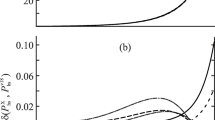Abstract
In this article, a model of hard spheres for critical fluid, based on the hypothesis on the coordination number of molecules in minimally bound infinite clusters, is considered. Variants of homogeneous (quasi-crystalline lattice) and heterogeneous (“Cayley tree forest”) molecular packings at the vertices of a uniform graph of order 3 are described. Using the theory of generalized charges and taking into account the found structures, the dependences of the critical molar volume on electronic structure parameters, which have the character of non-empirical laws, are derived. A priori calculations of molar volumes by the critical state model are in good agreement with the reference data for simple gases and linear hydrocarbons.





Similar content being viewed by others
References
Balescu R (1975) Equilibrium and nonequilibrium statistical mechanics, vol 398. John Wiley & Sons, Chichester, New York, p Ch.10
Landau LD, Lifshits EM (2013) Course of theoretical physics, Vol.5, Statistical physics, Part 1. Butterworth-Heinemann, §84
Guggenheim EA (1945) The principle of corresponding states. J Chem Phys 13:253–261
Van Hook WA, Rebelo LPN, Wolfsberg M (2007) Isotope effects on VLE properties of fluids and corresponding states: critical point shifts on isotopic substitution. Fluid Phase Equilib 257:35
Tomaschitz R (2019) Effective Hamiltonians and empirical fluid equations of state. Fluid Phase Equilib 496:80
Amani MJ, Dehdari L, Ghamartale A (2019) Modelling density and excess volume of hydrocarbon + water mixtures near the critical region. Fluid Phase Equilib 492:55
Haghighi B, Papari MM, Niafari M, Ghasemi H (2006) Molar volume for mixtures of methane with krypton, argon, ethane and carbon monoxide using the ISM equation of state. J Mol Liq 123(2–3):134
Venkatraj M, Bratschi C, Huber H, Gdanitz RJ (2004) Monte Carlo simulations of vapor–liquid equilibria of neon using an accurate ab initio pair potential. Fluid Phase Equilib 218:285
Heyes DM (2015) The Lennard-Jones fluid in the liquid-vapour critical region. Comput Methods Sci Technol 21(4):169
Poling BE, Prausnitz JM, O’Connell JP (2004) The properties of gases and liquids. McGraw-Hill, New York
Ono S, Kondo S (1960) Molecular theory of surface tension in liquids. Structure of liquids/Struktur der Flüssigkeiten. Encyclopedia of physics/Handbuch der Physik, vol 3/10. Springer, Berlin. https://doi.org/10.1007/978-3-642-45947-4_2
Dolgonosov AM (1998) Calculation of adsorption energy and Henry law constant for nonpolar molecules on a nonpolar uniform adsorbent. J Phys Chem B 102:4715 The first article, where the generalised charges are introduced
Dolgonosov AM (2009) The electron gas model and the theory of generalized charges for the description of interatomic interactions and adsorption. URSS (LIBROKOM), Moscow (Rus.)
Dolgonosov AM (2001) A theory of generalized charges for describing interatomic interactions. Russ J Phys Chem (Engl Transl) 75:1659
Dolgonosov AM (2002) The screening effect in interatomic interactions. Russ J Phys Chem (Engl Transl) 76:2015
Dolgonosov AM (2016) The surface tension coefficients and critical temperatures of uniform nonpolar liquids from a priori calculations within the framework of the theory of generalized charges. Rus Chem Bul (Engl Transl) 65:952
Dolgonosov AM (2020) Hypothesis for coordination number of critical fluid molecules expressed in model potential and critical temperature for simple substances. Theor Chem Accounts 139:90. https://doi.org/10.1007/s00214-020-02590-3
Stephan S, Thol M, Vrabec J, Hasse H (2019) Thermophysical properties of the Lennard-Jones fluid: database and data assessment. J Chem Inf Model 59(10):4248–4265. https://doi.org/10.1021/acs.jcim.9b00620
Batsanov SS (1998) Some characteristics of van der Waals interaction of atoms. Russ J Phys Chem (Engl Transl) 72:894–897
Lide DR (ed) (2005) CRC handbook of chemistry and physics. CRC Press, Boca Raton
Dean JA (1999) Lange’s handbook of chemistry15th edn. McGraw-Hill Inc., New York
Author information
Authors and Affiliations
Corresponding author
Ethics declarations
Conflict of interest
The author declares that there is no conflict of interest.
Additional information
Publisher’s note
Springer Nature remains neutral with regard to jurisdictional claims in published maps and institutional affiliations.
Rights and permissions
About this article
Cite this article
Dolgonosov, A.M. Critical fluid density obtained from the theory of generalized charges in accordance with the hypothesis on the first coordination number. Struct Chem 32, 329–336 (2021). https://doi.org/10.1007/s11224-020-01675-w
Received:
Accepted:
Published:
Issue Date:
DOI: https://doi.org/10.1007/s11224-020-01675-w




